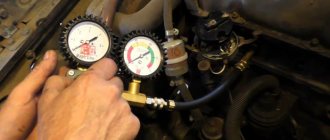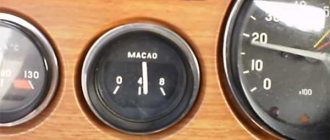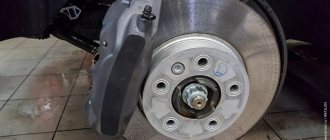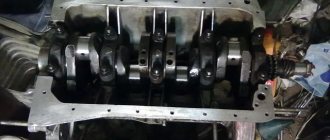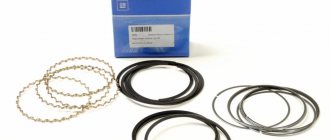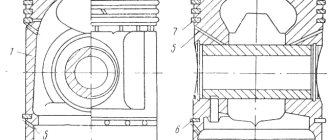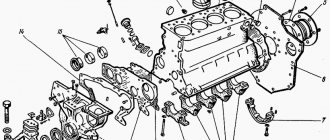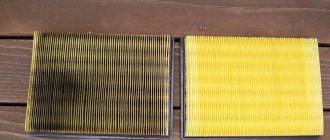When an engine is being repaired, car owners often ask what clearance should be on the piston rings. This question breaks down into two separate ones. For both compression and oil control piston rings, two parameters are standardized - the vertical (axial) gap and the gap size in the lock. Both parameters must be within certain limits, but we note right away that too much axial clearance, as well as excessive clearance in the lock, is nothing compared to what will happen if you install a ring with very small end clearance. In the latter case, of course, we were talking about the gap in the lock - it is otherwise called “end”, and we must talk about this value in more detail.
Why are there three rings on the piston?
The two upper rings, installed in the piston grooves, are needed to maintain compression. In the figure, these elements are indicated by the numbers “1” and “2”. And the lower ring, designated as “3”, is an oil scraper ring:
Less than 3 rings on the piston are not used in 4-stroke internal combustion engines
When the engine is running, the parts heat up, the metal expands due to heating, and the size of all gaps decreases. If the gap between the ends of the ring is smaller than recommended by the manufacturer, then after warming up such a ring will scratch the cylinder walls. Measurements must be taken without heating the part, and the ring itself must be placed in the cylinder:
Gap measurement cannot be performed without access to the cylinder block
To find out the size of the gap, use special probes (bars). Typically recommended values are in the following range: 0.2-0.5 mm. Still, be sure to check the documentation!
Everyone knows what gap is recommended for VAZ engines: on piston rings that create compression, it should be 0.25-0.4 mm (not less than 0.25 mm). Other values are suitable for oil scraper rings - 0.25-0.5 mm. As you can see, the lower limit here is the same, but this is not true for all internal combustion engines.
What does a violation of the gap between the cylinder and piston lead to?
Among the many problems with a car, there is one very common one, namely, a violation of the gap between the cylinder and the piston. How does this manifest itself?
Firstly, the engine starts knocking during the start process. Secondly, engine compression drops significantly. As a result, oil and fuel consumption increases greatly, and in the end, the engine simply refuses to work stably or stalls altogether. In general, if the gap between the cylinder and the piston is greatly reduced, then this will certainly lead to chips on the cylinder surface, as well as to strong heating of the block parts. In any case, if there are problems, then you definitely and without any options need to repair the piston group! Although, if you have the means, you can solve the problem right away: buy a new engine! Well, how? Is this an option? No? Then - renovation!
Repair of the piston group is a complete replacement of the cylinders, or boring of the cylinders.
And now the main question: how to check the gap between the cylinders and the piston? To take measurements, it is necessary to perform an algorithm for disassembling the cylinder head. Actually, this algorithm is a real overhaul of the engine - no more, no less! Why a major renovation? It’s simple, because when you disassemble and take measurements, problems with the crankshaft, camshaft, “dead” gaskets, worn bearings, liners, etc. will definitely come up. However, let's focus on the measurements for now.
What is needed to take measurements? You will need two tools: 1) a bore gauge - this is a tool that measures the internal diameter of the cylinder; 2) micrometer - a tool used to measure the diameter of pistons. Let's move on.
According to the outer diameter, pistons, as well as cylinders, are divided into five classes: A, B, C, D, E. The process of measuring the piston diameter is carried out on the “skirt” of the cylinder: the distance to the bottom of the plane is 52.4 mm. (Piston classification is a mark with a letter). The diameter of the cylinder is measured in two planes and four “belts”: they are located perpendicular to each other. If, as a result of measurements, the gap between the piston and cylinder is more than 0.15 mm, then repair of the pistons is necessary.
Attention: if the cylinder mirror has defects, then it is necessary to bore the cylinder. And one more thing: keep in mind that the cylinder is bored to the size of the nearest repair piston! Once the cylinder repairs are complete, it's time to select the correct size pistons.
By the way: it is very important to pay attention to the specific gravity of the pistons you choose. This is very important so that strong vibration does not subsequently arise due to the difference in mass during the reciprocating movement. Once the cylinder repairs are complete, it's time to select the correct size pistons.
By the way: it is very important to pay attention to the specific gravity of the pistons you choose. This is very important so that strong vibration does not subsequently arise due to the difference in mass during the reciprocating movement
Once the cylinder repairs are complete, it's time to select the correct size pistons.
By the way: it is very important to pay attention to the specific gravity of the pistons you choose. This is very important so that strong vibration does not subsequently arise due to the difference in mass during the reciprocating movement
And one last thing. Before you begin repair work, do not take a look at the operating and repair manual for your car.
If you need a job for the summer, then you need to go to chelyabinsk.pomogatel.ru, where you can view all available nanny vacancies for the summer.
Measurement technique
It was not said above what vertical or axial clearance is. The essence of this parameter will become clear during the following steps:
- Bring the ring to the side of the cylinder;
- Place the ring with the outer side in the slot that is intended for it;
- Using a set of feeler gauges, determine the gap size (see figure).
The diagram shows how to measure the vertical gap.
This is how the axial clearance of the rings is always measured.
Now let’s determine what gap remains on the piston rings between the ends if they, that is, the rings, are inside the cylinder. The ring itself is immersed in engine oil, and then it needs to be moved along the walls of one of the cylinders - the same one where it will “work”:
The gap is measured when the ring is clamped by the cylinder walls
To perform this operation, a piston is usually used if the latter has already been removed. The point is to bring the ring to approximately the level at which it is when the motor is running. Let's say the block was bored recently. Then the ring is moved down 3-5 mm (this is enough). And then, using a set of probes, the operation is brought to completion.
The motor oil used to lubricate the rings can be any type. Everything in the engine burns successfully!
How to measure gaps on rings and what they should be
When an engine is being repaired, car owners often ask what clearance should be on the piston rings. This question breaks down into two separate ones. For both compression and oil control piston rings, two parameters are standardized - the vertical (axial) gap and the gap size in the lock. Both parameters must be within certain limits, but we note right away that too much axial clearance, as well as excessive clearance in the lock, is nothing compared to what will happen if you install a ring with very small end clearance. In the latter case, of course, we were talking about the gap in the lock - it is otherwise called “end”, and we must talk about this value in more detail.
Ratings for different Lifan internal combustion engines
When installing new motor rings that do not have external defects, it is not necessary to measure the axial clearances. This is precisely why the values of these gaps are not given in the repair literature. But the gap in the ring lock needs to be measured and assessed using the manufacturer’s recommendations. The lock clearance limits are listed below.
Solano 620
The engine of the Solano 620th model sedan is an analogue of the Toyota 4A-FE engine, the volume of which is 1.6 liters. So we will use the recommendations of this company (Toyota):
- Upper compression: 0.250 – 0.450 (1.050);
- Lower compression (AE-92, AT-180): 0.150 – 0.400 (1.000);
- Lower compression (AE-101, AT-190): 0.350 – 0.600 (1.200);
- Oil scraper: 0.100 – 0.500 (1.100).
The maximum limit value is indicated in parentheses. If it is exceeded, it is necessary to carry out major repairs - boring the block and so on.
Crossover X60
Here we have an engine, like in the Toyota RAV4 crossover (1.8). Therefore, we will again use Toyota’s recommendations:
- Upper compression: 0.250 – 0.450 (1.050);
- Lower compression: 0.350 – 0.600 (1.200);
- Oil scraper: 0.150 – 0.500 (1.050).
We hope no questions arise here. The values are suitable for the 1ZZ-FE engine (1.8 l).
Functions of piston rings
Piston rings are designed to perform the following functions:
- Sealing the piston space while maintaining pressure with the upper compression rings.
- Heat removal from the walls of the sleeve.
- Reduced oil consumption.
Checking the clearance in the locks inside the cylinders
The piston ring lock is the joint between two ends that are capable of being compressed to hundredths of a millimeter. The ends have a straight or oblique cut, with a rectangular profile section.
When placing the rings in the grooves, the joints are placed at an angle of 120° (if 3), and with two rings - at 180°, which limits the leakage of gases and oil into the crankcase, under the piston.
Oil scraper rings are designed to remove excess motor lubricant from the cylinder walls. They are designed to leave a thin layer of film on the mirror, so small that it is measured in microns. The design provides radial, through slots through which the oil removed from the walls is drained into the crankcase.
Available in cast iron with slots or extensions. They represent two rings (upper, lower), a pair of radial or axial expanders.
About the thermal gap
Locks are considered a common element of the rings, since the goal is to compensate for thermal expansion during operation. Locks undergo gas pressure, temperature loads, and other inert influences. This tension is absorbed by the tiny distance between the ends of the rings.
Why is the thermal factor needed?
Let’s imagine the absence of a gap between the spans of bridges, railway rails or expansion joints on main pipelines. Solar heating and expansion, for example, of the metal of rails that do not have a gap during installation, lead to their inevitable bending with all the ensuing consequences.
In the case of piston rings, the lack of butt clearance leads to breakage of the piston.
So, the free rotation of the rings eliminates butt contact inside the piston groove. The design includes cuts to prevent jamming from overheating. This feature contributes to a tight contact with the cylinder mirror.
The permissible joint interval does not exceed 0.3-0.6 mm. With a small joint gap, for example 0.2 mm, heated parts can leave marks on the cylinder.
By the way, preference is given to parts with oblique cuts at the ends. Straight ends have a lot of pressure on the walls, which prematurely damages the liner, causing oil leakage.
Thermal clearance requirements
Functional requirements for thermal clearance include:
- Heat removal from the piston at the moment of ignition of the mixture . Otherwise, the piston will burn out under the temperature of the combustion chamber.
- Piston space sealing function . The resulting pressure should evenly press the rings against the cylinder walls. Achieving such touch requires setting the correct distance.
- Requirements for oil scraper discs responsible for supplying the required amount of lubricant. Compliance with this rule keeps oil and gasoline consumption at the level of factory standards.
Options
Set gaps on rings
The established gap should correspond to 0.6-0.3 mm, and the side gap between the wall should not exceed 0.08-0.04 mm.
This is interesting: Relay for power windows VAZ 2110
The value comes from the fact that exhaust gases act on the rings from the inside of the groove, pressing them against the wall. The coordinated functioning of compression and oil scraper rings allows for complete combustion of the mixture. This depends on how they are placed in the piston groove.
Therefore, a small value between the ends after warming up will lead to scuffing of the cylinder mirror.
The gap is measured with a feeler gauge and is regulated at 0.2-0.5 mm. For VAZ model engines, a value of 0.25-0.04 mm is provided on the sealing rings. Oil scrapers have 0.25-0.5 mm.
The first ring on top (compression), as loaded from alloy cast iron, is sprayed with chromium. The porous coating of this metal is capable of holding the required mass of engine oil.
Plasma coating of a layer of molybdenum on the rings promotes wear resistance and low friction with the cylinder.
Memo
The lock on the separator is painted blue
When choosing a repair size, you need to be guided by the product designation, including the engine model, kit number, product size. Additionally, the markings, which are located in a certain place of the product (close to the end), are checked. Expansion springs with a ground surface are carefully considered.
What is the normal thermal clearance for piston rings?
The piston moves inside the cylinder, receiving the ignition pressure of the mixture in the combustion chamber. To do this, maintain an interval between the piston and the liner mirror. This is required by reducing friction and reducing wear of piston group parts. At the same time, engine oil is designed to minimize the production of rubbing joints, eliminating lubricant seepage under the piston. An important function remains the removal of heat to the cylinder walls.
What gap should be on the piston rings?
The internal combustion engine is actually a heat engine. During the operation of such an engine, a number of loaded parts in the design of the CPG and timing belt are subject to thermal expansion as a result of significant heating. For this reason, for normal operation of the internal combustion engine, individual designs provide for independent adjustment of the thermal clearance of the valves (in the absence of hydraulic compensators).
Read in this article
How to choose piston rings
The selection of piston rings means that the dimensions of the piston rings must necessarily correspond to both the dimensions of the pistons and the dimensions of the cylinders. Let us add that selecting piston rings by size is a little easier compared to selecting the pistons themselves. This is due to the fact that repair piston compression and oil scraper rings for various engine models are more or less interchangeable today. This means that you can purchase both original piston rings and select parts from a third-party manufacturer.
Selection of rings by size
It is necessary to select rings taking into account the following basic parameters:
- piston ring height;
- piston ring diameter;
Any high-quality analogue that has the required dimensions often becomes available without any problems. To be completely sure, it is also necessary to take into account the radial width of the piston rings, or rather, the correspondence of this width to the piston grooves. In other words, the depth of the grooves in some cases may be insufficient.
As for compression rings, such rings are structurally similar, often have the same or almost the same radial width, so problems usually do not arise after installing correctly sized rings from this group. The selection of oil scraper rings, on the contrary, requires increased attention both to the design of the ring itself (box-shaped, stacked oil scraper rings), and additional clarification of their radial width according to special catalogs of the ring manufacturer.
I would like to add that selecting piston rings for diesel engines is more difficult. Compression rings for diesel engines are molybdenum coated and also have a trapezoidal profile, which can additionally have different angles. Oil scraper rings in diesel engines are usually box-shaped, but this fact must also be checked in catalogs, since there are cases of installation of set rings on a diesel engine.
Please note that it is highly not recommended to install piston rings from a gasoline engine on a diesel engine. At the same time, in some cases, it is possible to install piston rings from a diesel engine to a gasoline engine
Which piston rings are better
In addition to choosing from the available nominal and repair sizes of rings, you will also need to separately select the material of manufacture. It is quite fair to say that piston rings for a low-power, low-speed engine, which was developed 10-15 years ago (even taking into account their full compliance in size), will be able to function normally and for a long time in a highly accelerated turbocharged power unit.
The fact is that the materials, coating applied and tolerances on the geometry of the rings may well differ
During the selection process, close attention should be paid to these factors, especially in the absence of accurate data in the manufacturer’s catalogs. It should also be added that rings for new engines usually work well in older internal combustion engines, but not vice versa
The upper ring is the most heavily loaded during the operation of the internal combustion engine. For this reason, such rings are made of alloy cast iron, which is also plasma sprayed with chromium or molybdenum. Chrome has a porous structure, which allows it to effectively retain the required amount of engine oil. Coating with chromium or molybdenum increases the wear resistance of the rings and also provides a low coefficient of friction during contact with the cylinder walls.
Cast iron piston rings are considered to be of sufficient quality. Such parts are made of high-strength cast iron, which has improved properties and actively resists wear. Oil scraper rings are available in chrome plated and also without chrome coating. Steel rings additionally equipped with a spring element are also on sale.
Chrome rings are usually installed on engines with a high compression ratio, which implies more severe loads on the internal combustion engine and CPG. Foreign-made civilian cars often have stainless steel piston oil rings. Such rings are characterized by a long service life, low weight and reasonable cost.
What gap should be on the piston rings?
There are two types of piston rings installed on the piston:
- compression rings;
- oil scraper rings;
Compression rings are also divided into upper compression ring and lower compression ring. The purpose of these rings is to seal the combustion chamber and prevent the breakthrough of a significant part of the exhaust gases into the engine crankcase. Oil scraper rings remove excess engine oil from the cylinder walls, so that excess oil does not enter the combustion chamber.
Such repairs usually involve boring the cylinder block and installing repair pistons and rings. The specified thermal gap is a tolerance that takes into account the expansion of the part with heating, that is, when certain parameters change. The permissible gap between the piston and the cylinder is the gap at which normal performance of all elements is observed. The parts fit very tightly to each other, but there is no damage or jamming.
In other words, the permissible piston ring clearance allows, after thermal expansion, to achieve such a thermal space (the gap between the piston and the cylinder) in which the piston rings tightly pressed to the cylinder walls create a reliable seal. At the same time, the rings, expanded under the influence of high temperature, must remain mobile in the grooves on the piston and create a reliable seal, without interfering with the normal movement of the piston. At the same time, the piston rings must effectively remove excess heat from the heated pistons.
The piston ring is not solid, as it has a cut (lock). Thanks to this cut, it is possible to avoid jamming when heated and achieve elasticity of the ring for tight pressing against the cylinder walls. After installing the ring on the piston and placing the piston in the cylinder, a gap is formed in the piston ring lock. This gap is 0.3-0.6 millimeters.
The piston ring lock can be made in the form of a straight or oblique cut. A lock with a straight cut is less preferable, since in the area of the cut edges a strong pressure is created on the cylinder walls. This design feature of the lock causes accelerated wear of the cylinder mirrors, after which gas leaks occur and oil consumption increases due to waste. Increasing the piston ring gap beyond the permissible parameters worsens the seal. Reducing the ring clearance can lead to their destruction, jamming or the formation of scoring on the cylinder walls.
Engine piston rings
In an internal combustion engine (ICE), piston rings (PR) serve as a seal between the cylinder walls (liners) and the piston, due to which compression is created in the cylinders. If you forget to put the PC into the engine during assembly, the engine will not start, since the necessary compression of the working air-fuel mixture will not be ensured.
In passenger cars, three rings are standardly installed on each piston - two compression rings and one oil scraper ring, and oil scraper rings can be stacked, that is, consist of several elements. Compression piston rings (CPRs) are used to create compression in the cylinders and are always made of high-strength cast iron with various additives. The upper CPC has the greatest strength, since it operates in the most severe temperature conditions and experiences maximum loads.
Engine oil piston rings (OPRs) are needed to drain oil from the cylinder walls; if the rings do not perform their function, the engine will consume oil. MPKs can be either cast iron or steel, and cast iron PCs are almost always made in one piece, but steel oil scraper rings can only be assembled (composite). Steel MPC for one cylinder consists of:
- two spring steel rings;
- axial expander;
- radial expander.
How does the thermal clearance of piston rings affect oil consumption?
Recently, there has been a tendency among manufacturers to increase the thermal clearances of compression piston rings. The gaps on such rings range from 1 to 2 mm. Typically, such an increased gap is relevant for the second compression ring.
The fact is that the clamping of the piston rings (both the first upper and the second compression) depends almost entirely not on the degree of elasticity of the ring itself, but on the pressure that arises during the combustion of the fuel-air mixture charge in the working chamber. Exhaust gases enter the grooves on the piston and then end up on the back side of the rings. As a result, the pressing force of the rings against the cylinder wall increases. Gases most strongly affect the first (upper) compression ring, and also affect the pressure of the second compression piston ring.
Taking into account the above, it should be noted that when the engine is running at idle speed and at low loads, the gas pressure is noticeably weaker compared to the mode of medium and maximum loads. For this reason, the compression piston rings are not pressed so tightly against the cylinder wall at such internal combustion engine operating modes.
To reduce oil consumption, manufacturers increase the thermal clearances of the piston rings. Through the increased gaps, gases, even under relatively low pressure, penetrate much more actively into the annular groove, after which they end up on the back side of the ring.
The ring pressure is improved, the sealing of the combustion chamber remains at an acceptable level, and oil consumption can be reduced. The only drawback of the increased ring gap is the greater amount of gases that enter the crankcase through the increased gaps.
Signs of piston ring wear
To understand whether the piston rings need to be replaced, it is necessary to study the symptoms that directly or indirectly indicate the need for such a replacement. Let us immediately note that you should not count on the amount that was initially announced by a mechanic or car service in response to a customer’s question about how much it costs to replace piston rings.
The fact is that it is often not possible to change only the piston rings and completely solve the problem, since after opening the engine, additional hidden defects are usually revealed. For this reason, it is necessary to be prepared in advance for more serious engine repair costs.
An impending replacement of piston rings is determined by the following signs:
- the engine loses power;
- the car is very bad;
- in some cases, the engine is difficult to start “hot”;
- there is an increased consumption of engine oil;
- the engine produces blue or gray smoke;
- fuel consumption increases;
The compression indicator, by which the condition of the engine can be determined, depends on the general condition of the rings and the entire CPG. Typically, with the symptoms described above, compression in the cylinders decreases and crankcase gas pressure increases.
Loss of power, increased fuel consumption and difficult starting are most often the main reasons that force the owner to change the piston rings or do a comprehensive repair of the internal combustion engine. A power unit with faulty rings has difficulty starting, especially after being idle in the cold season. When driving under load, such an engine does not “pull”.
Piston ring failures can be caused by natural wear and tear, as well as engine overheating. In the second case, even on a new motor, the rings lose their properties and cease to fulfill their intended purpose. Box-type oil scraper rings are most susceptible to overheating.
Significant engine oil consumption often occurs due to the fact that a worn oil scraper ring does not remove the required amount of oil from the cylinder walls and actively passes lubricant through leaks into the combustion chamber. The result is coking and smoking of the engine. Also, the remaining unburned oil in the engine actively pollutes the exhaust system, damaging filters and catalysts. The problem gets even worse.
To accurately diagnose the condition of the CPG, compression measurements must be supported by analysis of the color and content of exhaust gases. The fact is that the deterioration in the quality of the piston ring seal can be compensated by engine oil. In this case, the compression indicator is close to the permissible value, but oil consumption will still increase.
Remember, operating an engine with worn rings causes the wear of the cylinder bore to progress significantly. For this reason, it is necessary to change the piston rings as soon as possible after the fault has been accurately determined. This recommendation will help avoid increasing the cost of subsequent engine repairs.
Increased fuel consumption in the event of problems with the piston rings occurs as a result of the fact that compression is reduced and power has dropped. At the same time, the driver continues to drive at his usual pace, pressing the gas pedal harder to compensate for losses. As a result, an enriched fuel-air mixture enters the cylinders, which does not completely burn. Spark plugs often become flooded with fuel in such conditions.
Another unpleasant moment is the penetration of gasoline or diesel fuel through worn piston rings into the engine crankcase and subsequent mixing of fuel with engine oil. The oil in the lubrication system dilutes, loses its protective and other useful properties, and the wear of the loaded parts of the cylinder head and CV gear greatly increases.
Let us add that today the practice of using an additive to clean piston rings into oil or fuel is quite widespread. Also, owners sometimes pour so-called engine decoking into the cylinders. This is done in order to clean carbon deposits in the combustion chamber and try to restore mobility to the underlying piston rings to increase compression.
It should be noted that if obvious signs of a malfunction appear (heavy smoking, high oil consumption, low compression, etc.), an additive instead of replacing the piston rings is either a temporary measure or does not help correct the situation at all.
Let's sum it up
Both the service life of the rings themselves and the serviceability of the entire CPG depend on the correctly selected thermal clearance of the piston rings. Natural radial wear of the rings leads to an increase in thermal gaps, after which the sealing of the combustion chamber deteriorates.
It should be noted that a reduced clearance is much more dangerous for the engine. If the minimum gap in the locks (thermal space) is reduced to 0.2 millimeters, after the motor is heated and reaches operating temperatures, the gap in the lock may be completely absent. As a result, the ring puts a lot of pressure on the cylinder walls, ring wear increases significantly, heat transfer is disrupted, and the risk of scuffing increases.
How to choose the right piston rings. Correct selection of rings by size and materials, how to choose original rings. Useful tips.
When is it necessary to replace piston rings? How to install rings on the piston when replacing it yourself. Service life, rings, grinding in and running in.
Why do piston rings stick? The main signs for independently identifying a malfunction, diagnostics. Do-it-yourself decarbonization of piston rings.
Purpose, design features and principle of operation of piston rings of an internal combustion engine. Types of rings, gap size, main faults.
Purpose of the piston in the design of the internal combustion engine. Features and design of the piston, oil scraper and compression rings.
Purpose of the cylinder-piston group of an internal combustion engine. Design features, piston, rings, cylinder liner. CPG wear and repair.
Tips and tricks
It is quite obvious that the most convenient option for selection would be to use original piston rings. By original we mean piston rings, which are positioned as original spare parts by the engine manufacturer itself. At the same time, the original parts available for sale do not always allow the implementation of the assigned tasks during engine tuning or repair. In such cases, it is necessary to carry out a competent selection from a group of high-quality analogues.
- When selecting non-original piston rings, it is advisable to choose rings that were originally intended for an engine with similar characteristics. Such characteristics should be understood as volume, power, degree of engine boost, maximum crankshaft speed, compression ratio, etc.
- It should be noted that the installation of so-called “soft” rings, which have a shorter service life, allows you to minimize wear on the cylinder walls, thereby increasing the service life of the BC. In parallel with this, replacing the piston rings in this case will require an average of every 35-45 thousand kilometers traveled, which casts doubt on the feasibility of such a solution. Good quality piston rings have a service life of about 170-220 thousand km. When replacing them at such mileage, the engine still often requires crankshaft repair, restoration of the CPG, etc.
Finally, we would like to add that correctly selected and professionally installed non-original piston rings can, in some cases, last longer compared to original parts. It is also worth considering that high-quality analogues usually cost 10-25% less.
Source
Thermal gap in the piston ring lock
The engine is the main part in any car. Thanks to him, the car moves forward and the electronics work. Therefore, it is so important that every element of the motor is in perfect condition. Otherwise, there is a risk that the car will stop in the middle of the road and refuse to start.
The main elements of the engine are the cylinders. The pistons move in them, and the operation of the entire system depends on how well these parts interact. That is why it is so important that the piston ring clearance clearly fits into the standard.
Essentially, a micro-explosion occurs inside the cylinders, which forces the pistons to move in the desired direction. As a result, the crankshaft rotates and mechanical energy is generated.
Therefore, the piston ring clearance is also affected by high temperature, which is the result of a reaction that occurs inside the cylinders. At least, this is how the process occurs in an internal combustion engine.
Operation of diesel and gasoline internal combustion engines
To better understand the importance of piston ring clearance in engine operation, let's consider how the two most common systems work. In reality, the difference between them is not that great, at least in terms of design.
The main difference is the ignition process. In diesel engines it occurs due to increased pressure. As a result, the temperature rises, after which the nozzle injects fuel inside, and ignition occurs on its own.
The gasoline engine is designed a little differently. Instead of an injector, spark plugs are installed at the top of the pistons, which supply sparks. Naturally, with such a design, normal piston ring clearance is very important.
This is interesting: Bleeding shock absorbers before installation
What is piston ring clearance?
Every part of the internal combustion engine is exposed to high temperatures. As a result, expansion occurs. Due to this process, the initial parameters of the part change. This has the greatest effect on elements that are adjacent to each other.
The disappearance of thermal space negatively affects the piston ring clearance. This, in turn, has a bad effect on the operation of the piston, and therefore the entire engine. In order for the entire system to work without interruptions, this parameter must be monitored.
The thermal clearance of the piston rings is an important structural element that ensures the normal operation of the piston rings. For it to function properly, there must be enough space in the groove for free rotation. If the part gets stuck, then you will have to forget about normal heat dissipation.
What should the gap be?
Rings in the piston can be compression or oil scraper. The main task of the former is to retain the burnt gases inside the cylinder. In turn, oil scrapers must remove excess oil from the walls.
The piston rings are not solid. They have a small cut, which is called a gap. Thanks to it, the rim does not jam when heating occurs. Moreover, this structural element ensures that the piston is pressed as tightly as possible against the cylinder walls.
If the described range is not observed, there is a high risk of damage to the cylinder and failure of the entire engine. An oblique cut is considered optimal for normal operation. Thanks to it, the pressure exerted on the walls is more uniform. A similar effect can be achieved due to thinner edges.
In most cases, amateur mechanics try to minimize the piston ring clearance. Therefore, by all means, bring the distance to 0.2 mm. The result of excessive zeal is scoring on the rings and cylinders. Such deformations appear due to the fact that when heated, the space in the lock decreases. Because of this, cutting into the cylinder wall occurs.
The role of piston rings in engine operation
There are a number of conditions, the observance of which guarantees long-term operation of piston rings. They largely depend on the characteristics of the gap. In order for the engine to last a long time, the correct clearance is necessary, which helps in controlling parameters such as:
- Temperature. The ability of the system to operate depends on this parameter. If the temperature is too high, the piston will melt in a few seconds.
- Pressure. In this case, the piston rings play the role of seals. It goes without saying that without the correct clearance this function will be difficult to implement. When pressure occurs, the circles are pressed against the plane of the cylinder. The correct gap allows the pressure force to be distributed as consistently as possible.
- Oil supply. Oil scraper piston rings are responsible for this parameter. They have two jumpers. They are the ones who regulate the supply of the substance in the right quantity. Typically this parameter is set at 1-2 microns. With optimal supply, gasoline consumption is reduced.
When these parameters are set correctly, the service life of each engine part increases several times. Piston rings and their clearances play a big role in their adjustment.
Review of popular models of piston rings VAZ 2109 – 2115
There are many companies that produce piston rings, as well as many fakes, and there is simply not enough time to look through them all. Therefore, let's look at those manufacturers of piston rings that differ from others in normal quality and price. The first thing I want to recommend is piston rings.
We recommend: When is it necessary to replace the oil pan gasket of a car engine?
Piston rings from .
These companies produce piston rings for VAZ cars of various diameters and are perfect for us. They are most likely produced in China, because the original ones will cost much more. But this does not mean that everything is so bad, their quality is excellent. I still recommend the rings, because their price is much lower than that of Mahle, and the quality is the same, so why pay more and overpay for the brand.
The upper compression ring of these manufacturers is chrome-plated steel, but its copper-plated one, which is clearly visible in the top photographs. The second compression ring is black and made of cast iron, but the ring from it has a darker color.
I recommend using metal oil scraper rings, because, unlike box-type rings, they fit perfectly in the cylinder, are resistant to overheating (they do not lose their spring properties) and their main advantage is that they work as two rings independent of each other. The rings are box-type, very afraid of overheating. When they overheat, they lose their spring properties and do their job poorly. And one more serious disadvantage: they require very careful running-in. At the slightest deviation from the running-in conditions, the working edges of the ring may break off in some places and allow oil to leak through.
Of course, there are other manufacturers of piston rings, but as usual they are complete fakes and sometimes it’s not possible to choose quality ones
How to measure piston ring clearance
At the first stage, you just need to visually inspect the part. It should not have cracks or any other defects. If you notice even minor mechanical damage, the element must be replaced with a new one.
Some preventive procedures will also not hurt. The piston head must be cleaned of carbon deposits, and special attention must be paid to the grooves that are located under the rings. Only after these procedures can you begin to inspect the gap.
Since there are only three rings in the device. Each has its own parameters:
- Upper compression 1-0.04-0.075 mm.
- Lower compression 2-0.03-0.065 mm.
- Oil scraper 3-0.02-0.055 mm.
Be extremely careful when taking measurements. Each ring has its own optimal gap size. For greater accuracy, use a micrometer. This is a device that allows you to measure all the parameters you need with extreme accuracy. For this purpose, there are special probes that allow you to easily and quickly take readings from the grooves.
